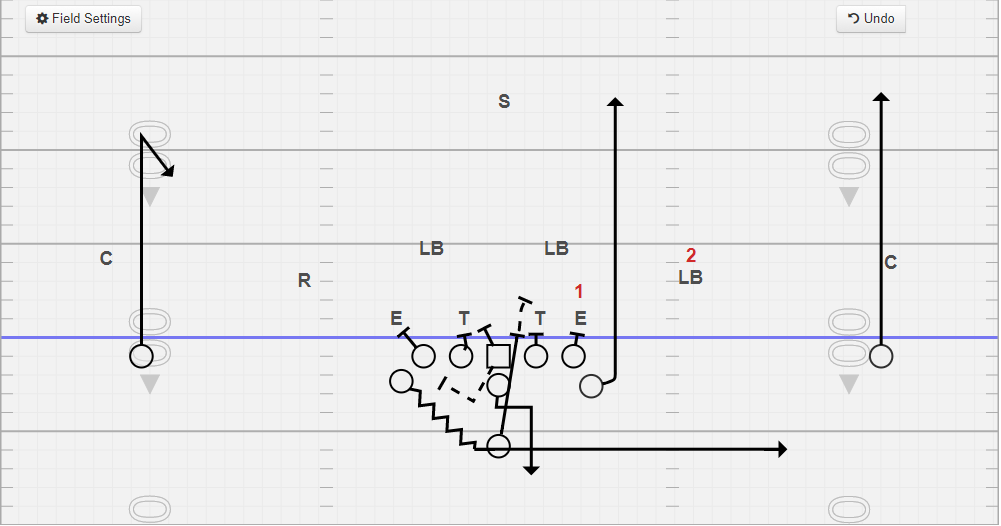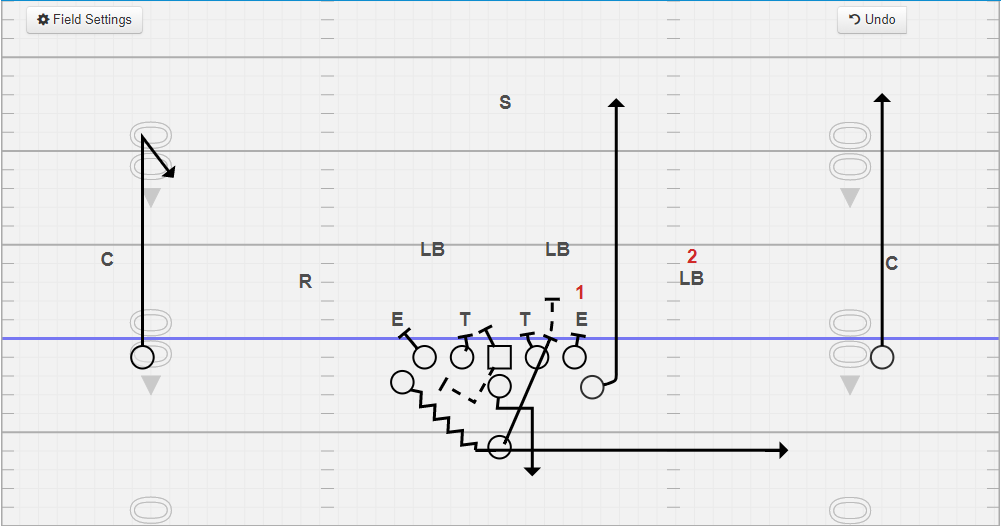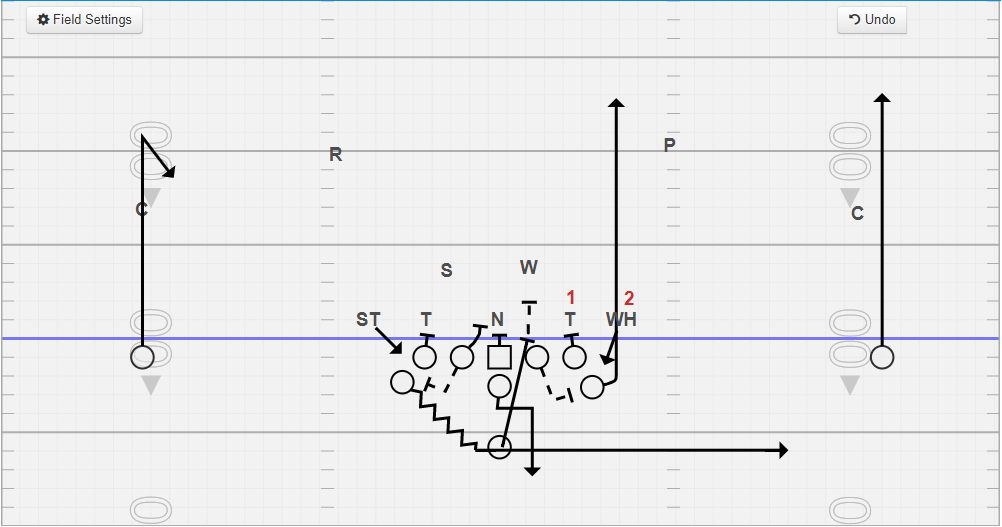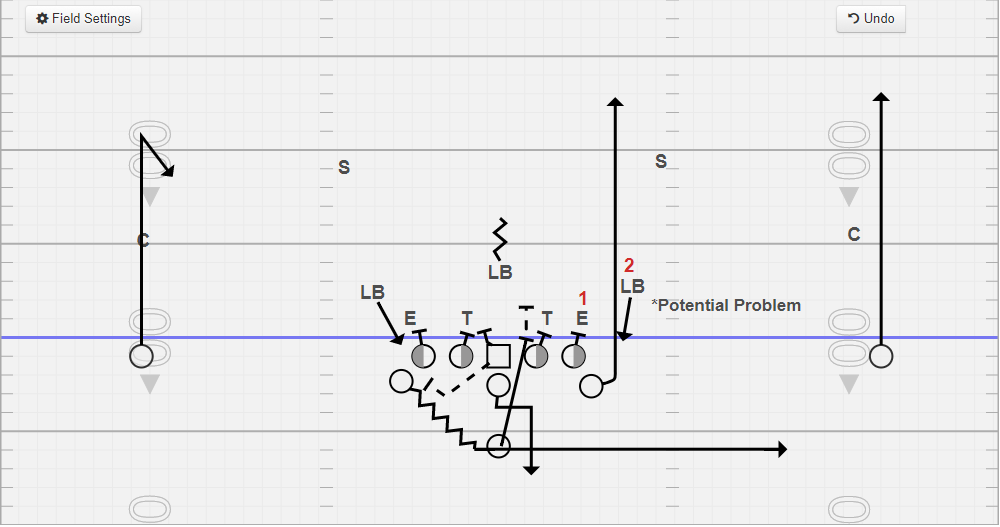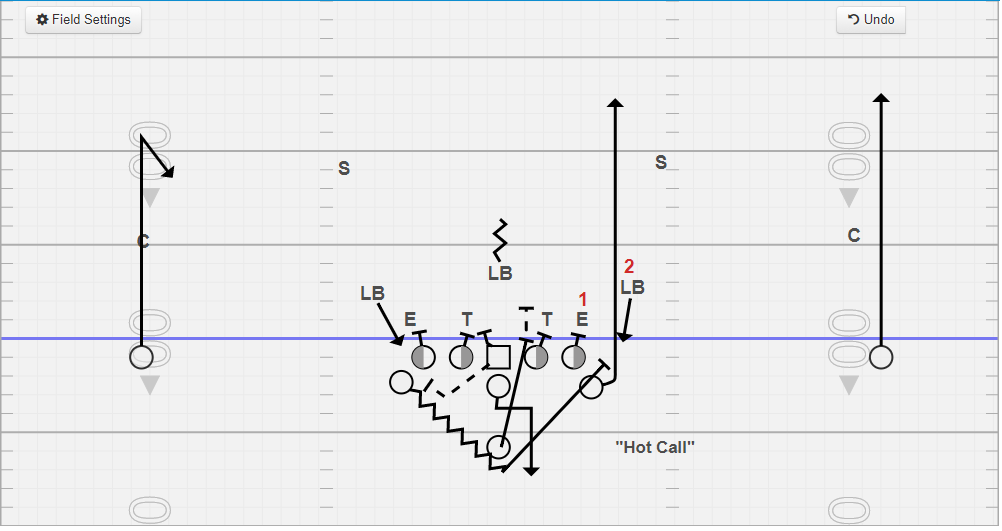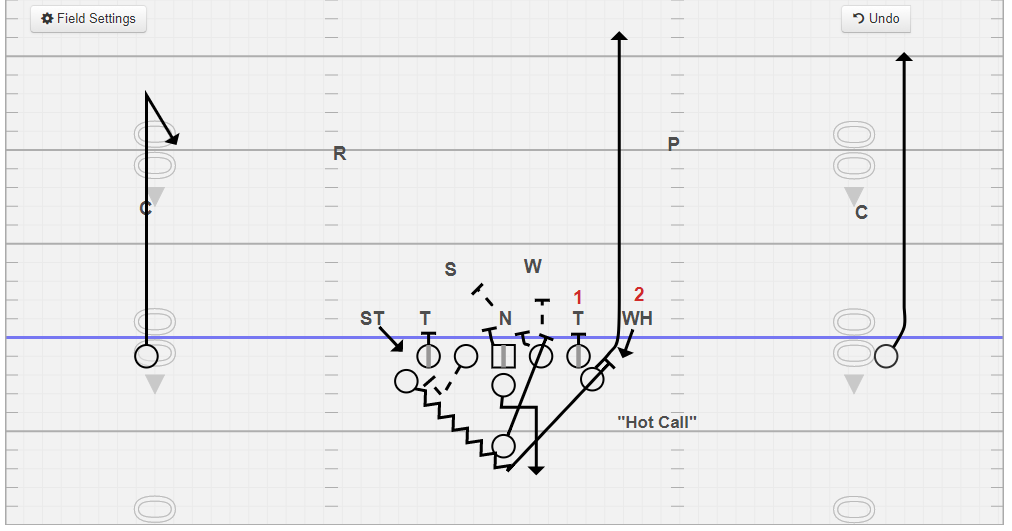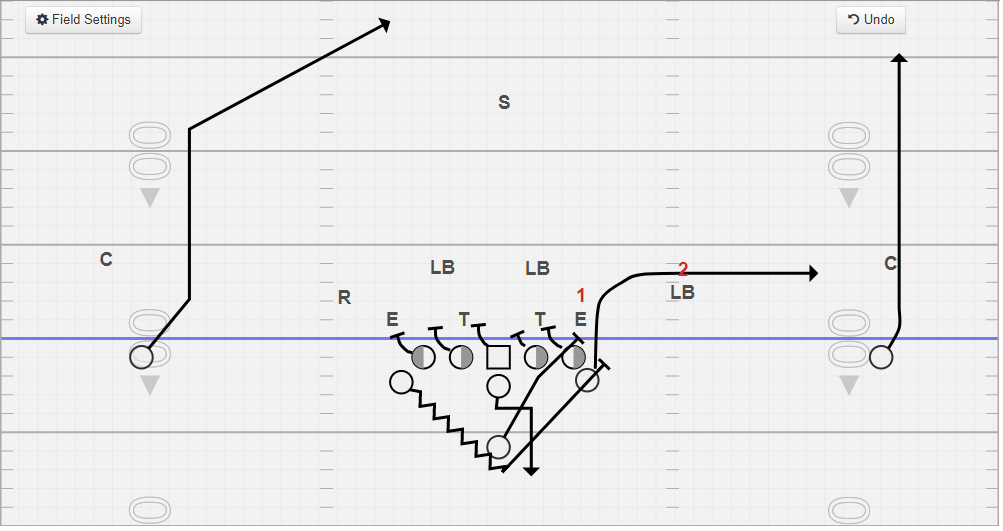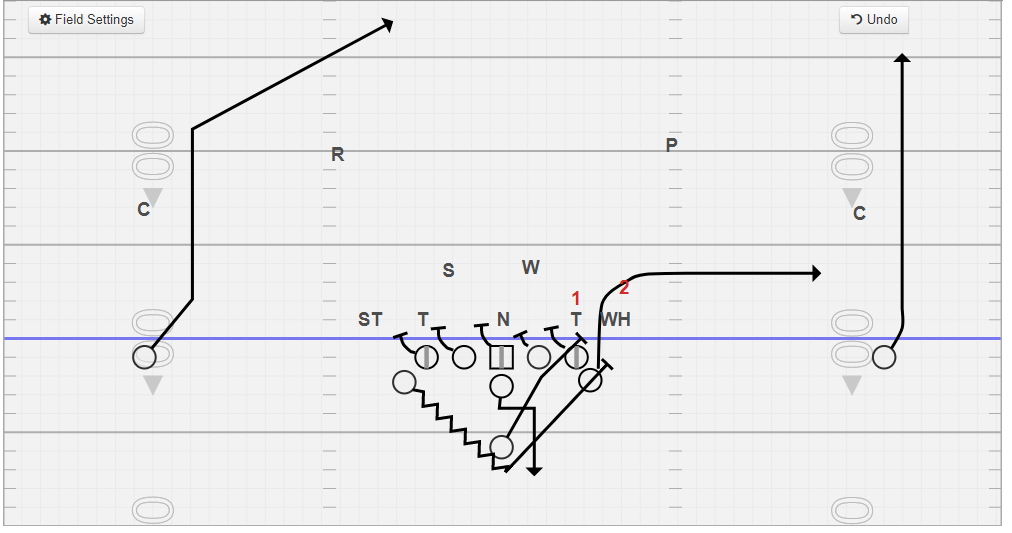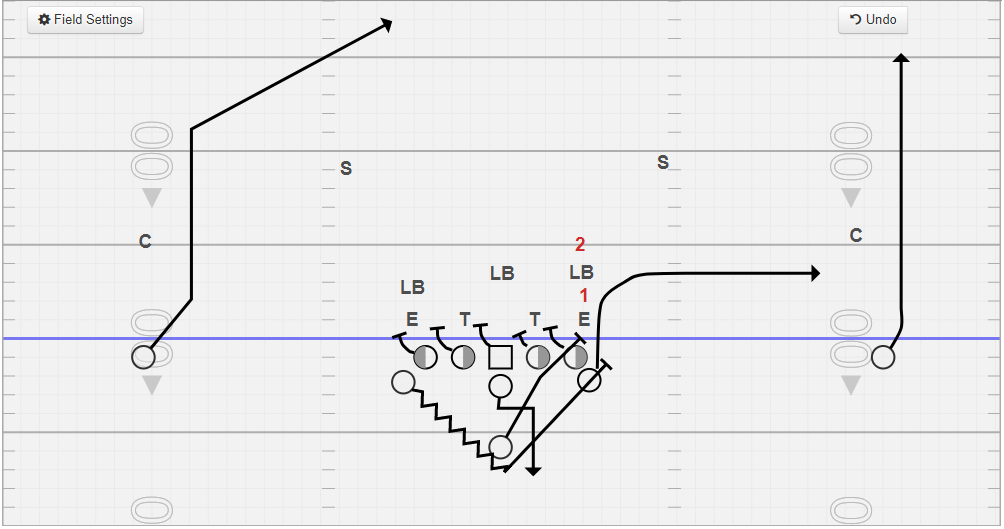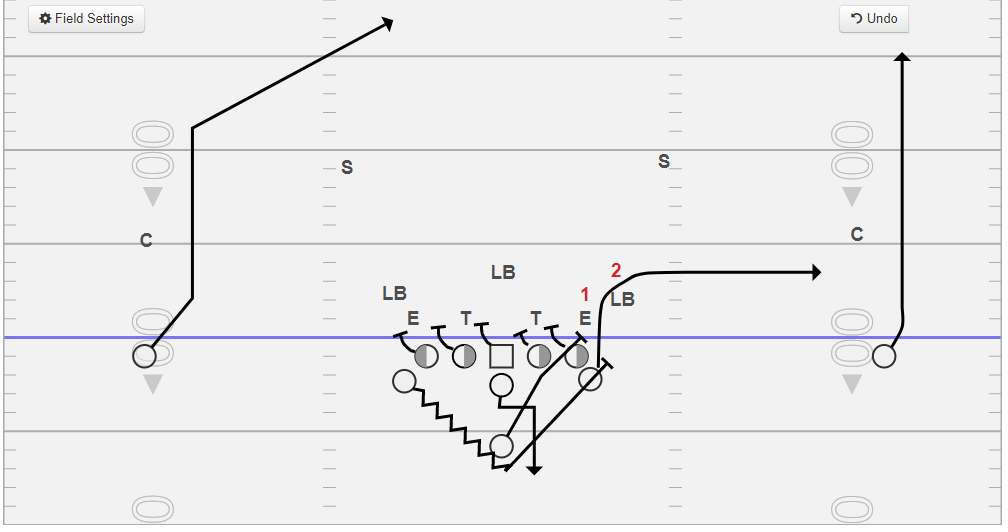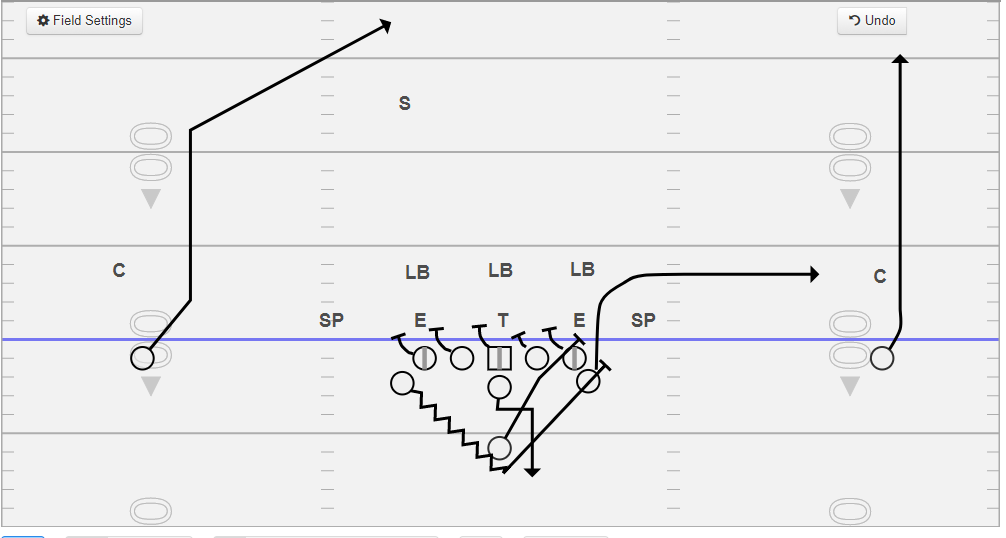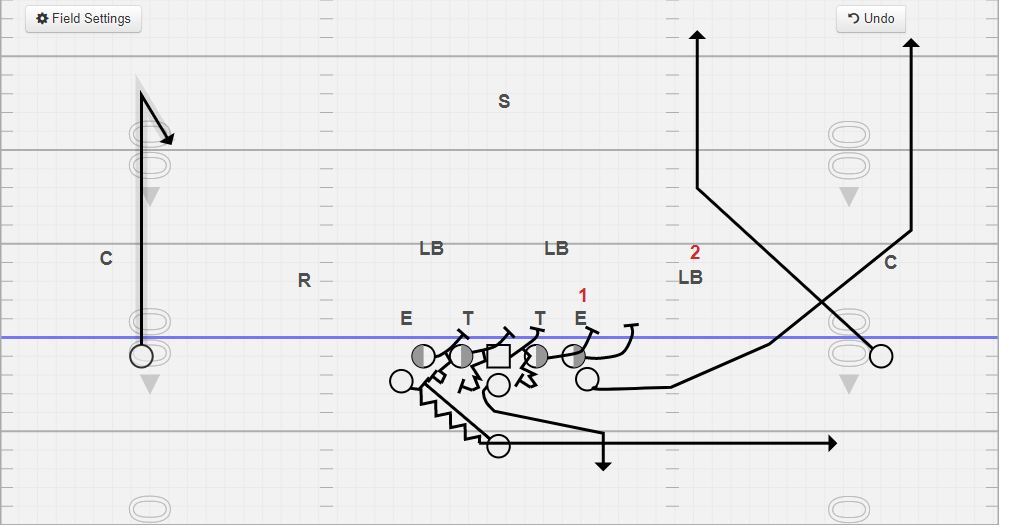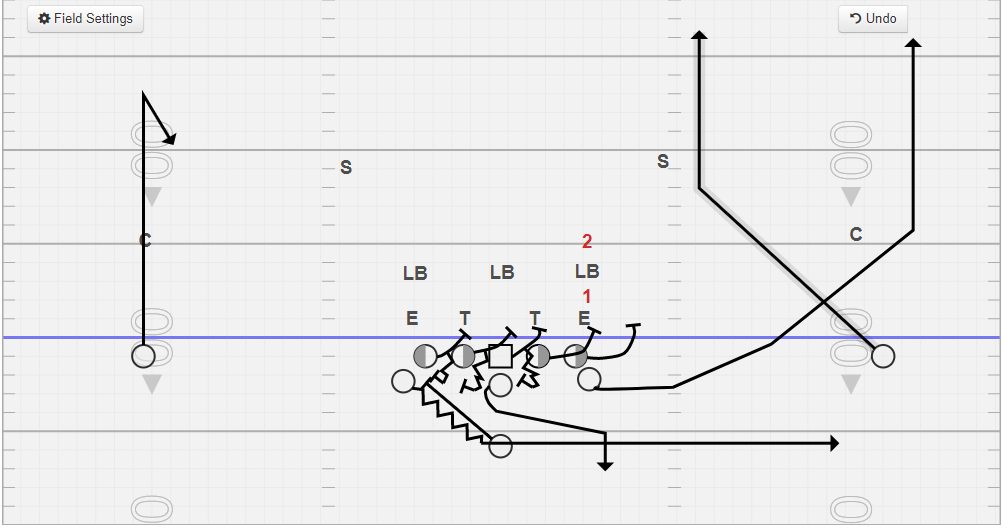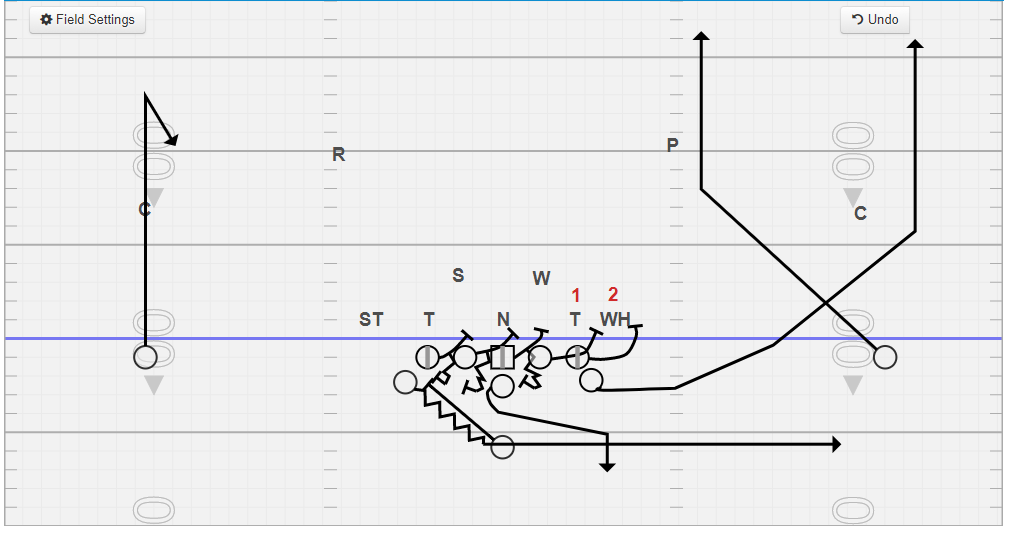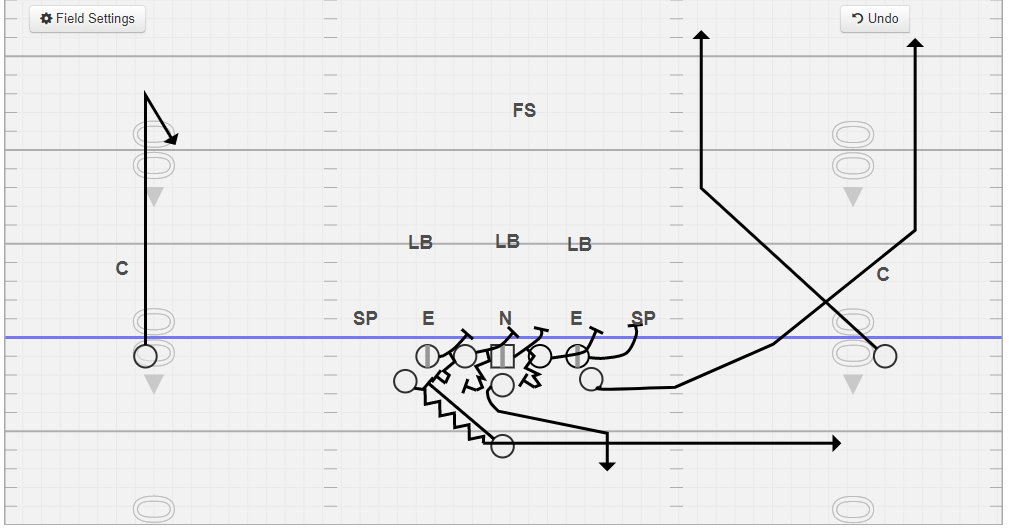Playaction Pass Protections within the Flexbone Option Offense
The month of April will be dedicated to Play Action Pass Protections and Passing Game within Option Football. We will begin our first blog with various options in pass protections. I will highlight three different types of pass protections that we use or have used in past seasons. The first protection we will discuss is a man scheme using the backside A backs to effect playside coverage and responsibilities.
Using the image above we will discuss play action off inside veer using a man scheme vs. a 4-4 defense with the 3 technique to the playside. We used this scheme to force the playside defenders to honor their option assignments, hopefully opening up windows and grass to attack with front side routes or with a backside route.
PST - The playside tackle has rules to block #1 in the count. He will use his base blocking fundamentals for the first three steps to give the illusion of inside veer and then sink the hips and re-punch the breast plate keeping his outside eye and hip on the inside of the defender. The reason he must re-punch upon dropping his hips is because the defender is taught to convert from run to pass by breaking the hands of the offensive player off his body/chest. We want to re-establish our hand placement before that can occur.
PSG - The PSG has rules to base man on or pick out for #2 if uncovered, if “hot call" block down to nose and spy backside linebackers. If covered, he will use his base blocking fundamentals for the first three steps to give the illusion of inside veer and then sink the hips and re-punch the breast plate keeping his outside eye and hip on the inside of the defender. The PSG will re-establish his hand placement after sinking his hips just like the PST. We also make adjustments, occasionally, and teach the PSG to always block the action key, which would be the first down lineman inside #1.
Center - The center has rules to base man on or pick out for the edge rusher backside if uncovered. If covered, the center will use the same base blocking to pass fundamentals the PSG and PST use. If uncovered and an even front, he must check the backside linebacker for any blitz in A gap then pick out for an edge rusher away.
BSG - The backside guard has rules to base man on or pick out for the edge rusher backside if uncovered. If covered he will use the same base blocking to pass fundamentals the PST/PSG/C use. If uncovered, we teach him to step down to A gap to ensure the nose/BSLB haven’t given immediate pressure and then he picks out to an edge rusher backside. We do make an adjustment vs. a 4i backside. We allow the BST to make a fan call to the BSG, which allows the BSG to take the 4i and the BST to take the edge rusher.
BST - The backside tackle has rules to base to fan. If anything other than a 4i, the BST will use his base blocking to pass fundamentals all the other lineman are taught. If the BST has a 4i, then he will make a fan call to the BSG and the PST will base the edge rusher and the BSG will base the 4i.
QB - Open up like IV, our steps and body demeanor look like inside veer but we crouch and pull the ball into our belly button, we don’t extend the ball into a true mesh with the B back, but try and make it look like a mesh based on proximity and pad level to hide the football. Then he pushes for depth and sets up based on the pass routes called. When running the fake to the left a right handed QB will complete his fake just like he did to the right, but make a left handed drop and then flip his hips to convert to a right handed set at the top of his drop to make the throw.
B Back - First he must sell inside veer, then settle in to the open gap based on the front structure, to the playside A gap or B gap and spy the pslb. If the pslb drops then he must then help inside or to an immediate threat. We tell the B back he has a conditional gap to protect based on the front, he needs to see and know where to fit into the protection pre-snap.
Below are examples where there are changes to the B back path to insert into protections or way we have to make adjustments to handle odd fronts.
312 vs. 4-4 w/2i to the playside
312 vs. a 5-2
312 vs. 4-3 w./hipped backers
* There is potential problem in the protection in the above diagram as the playside hipped backer is in a threatening position and could blitz, potentially unblocked. When we ran this protection we allowed the QB to recognize this pre-snap and make a “hot call”. This alerted the BSA to leave early in the cadence and become a part of protection playside to block the EMOLS. This “hot call” also affects the playside guard if uncovered, he will need to work down to the nose to help the center and then spy the backside linebacker. Below are examples of both scenarios.
312 vs. 4-3 w/ Hot Call
312 vs. 5-2 w/ Hot Call
The second pass protection we will discuss involves using the backside A back in the pass protection, similar to a “Hot Call” for the BSAs. This protection is a full slide protection for the offensive line and uses the B back and the backside A back as the edge protectors to frontside of the protection. We evolved into using this more and more because its a gap protection scheme that can handle stunts and blitzes better and there is carry over in teaching the OL our quick game protections. We don’t allow the OL to cut in this protection but we do in our quick game protection. We teach the OL to slide away form the call, for instance, 312 switch, the OL will slide left away for the inside veer play. Conversely, if we called 313 switch, then the OL would slide right. We teach the same concepts for 90/91 protections. You don’t get a outlet throw but you still affect the perimeter of the defense by using their option principles against them to open windows and you get the ability to protect with 7. The diagram below shows how the protection looks.
PST - Responsible for the gap immediately away from the playside/call side. If covered with no immediate threat in the gap away from the call then punch the down lineman with your outside hand and then slide. If there is no immediate threat in the adjacent gap then the player must get his eyes on second level defenders for blitz. *If an edge rusher is in an immediate threatening position then the BST will make a fan call to alert the BSG to a possible stunt by the adjacent down lineman. In this instance there will be no punch and slide. *Think 313.
PSG - Responsible for the gap immediately away from the playside/call side. If covered with no immediate threat in the gap away from the call then punch the down lineman with your outside hand and then slide. If there is no immediate threat in the adjacent gap then the player must get his eyes on second level defenders for blitz. The Diagram drawn doesn’t show a covered punch/slide concept because it is impossible to draw that way.
Center - Responsible for the gap immediately away from the playside/call side. If covered with no immediate threat in the gap away from the call then punch the down lineman with your outside hand and then slide. If there is no immediate threat in the adjacent gap then the player must get his eyes on second level defenders for blitz. The Diagram drawn doesn’t show a covered punch/slide concept because it is impossible to draw that way.
BSG - Responsible for the gap immediately away from the playside/call side. If covered with no immediate threat in the gap away from the call then punch the down lineman with your outside hand and then slide. If there is no immediate threat in the adjacent gap then the player must get his eyes on second level defenders for blitz. The Diagram drawn doesn’t show a covered punch/slide concept because it is impossible to draw that way.
BST - Responsible for the gap immediately away from the playside/call side. If covered with no immediate threat in the gap away from the call then punch the down lineman with your outside hand and then slide. If there is no immediate threat in the adjacent gap then the player must get his eyes on second level defenders for blitz. The Diagram drawn doesn’t show a covered punch/slide concept because it is impossible to draw that way. *If an edge rusher is in an immediate threatening position then the BST will make a fan call to alert the BSG to a possible stunt by the adjacent down lineman. In this instance there will be no punch and slide. *Think 312.
QB - Open up like IV, our steps and body demeanor look like inside veer but we crouch and pull the ball into our belly button, we don’t extend the ball into a true mesh with the B back, but try and make it look like a mesh based on proximity and pad level to hide the football. Then he pushes for depth and sets up based on the pass routes called. When running the fake to the left a right handed QB will complete his fake just like he did to the right, but make a left handed drop and then flip his hips to convert to a right handed set at the top of his drop to make the throw.
B Back - First he must sell inside veer. He will use his veer path and then kick to the edge. The aiming point is the pre-snap position of the outside hip of the PST, anticipating that the B back may make adjustments to his tract and aming points based on the front.
BSA - Must leave early in the cadence and work to clear the playside hip of the B back before the snap. His aiming point is the outside hip of the final path of the B back. He must be physical and under control when coming downhill from motion and work inside out on potential rush defenders.
Below are some more examples vs. other fronts:
312 Sideline vs. 5-2 with full slide protection
312 Sideline vs. 4-3 Stacked with full slide protection
312 Sideline vs. 4-3 Hipped with full slide protection
312 Sideline vs. 3-3 with full slide protection
*** ONE IMPORTANT NOTE I WANT TO MAKE, IF WE USE THESE TWO PLAYACTION PROTECTIONS OFF IV IN ONE SEASON WE MAKE SURE TO USE 392/393 FOR FULL SLIDE PLAYACTION PROTECTION AS THE PLAY NUMBER CALLED. FOR EXAMPLE, 392 SWITCH OR 393 SWITCH.
The last protection I will discuss in this blog post is play action off Toss/Rocket. Our staff researched this 4 years ago and we implemented it during the 2015 season. This protection has some carry over in teaching with all positions. The hardest thing to work out is the drop of the QB and where he sets up in the pocket that is created. The diagram below shows the basics of the protection and we will discuss the techniques as we go by position.
PST - He will use his reach blocking principles that we use for toss to set the frontside of this protection. It is important that he over reach the alley (C/D Gaps) to set the frontside edge of the protection. This block is a critical one because the QB has to setup behind the PST’s initial alignment. His aiming point is the same as toss vs. this 4-4 front structure (Inside shoulder on the OLB) but he must have the discipline to not gain ground past the 3 yard free blocking zone.
PSG - He will use his reach blocking principles that we use for toss to set the frontside of this protection. His aiming point is the outside hip of the defensive end in this diagram. We want him to try to get his left shoulder pad (in this diagram) on the far hip knowing that this may not happen. The hope is we at least reach the midline of the defensive end to give us the ability keep him out of the QB pocket. We realize the defensive end may react to the PST tackle’s reach block and may stretch away from the PSG but we know he will redirect and play vertical once he reads pass, so the PSG needs to keep coming on the reach block and be patient. He must have the discipline to not gain ground past the 3 yard free blocking zone.
Center - He will use his reach blocking principles that we use for toss to set the frontside of this protection. His aiming point is the outside hip of the defensive tackle in this diagram. We want him to try to get his left shoulder pad (in this diagram) on the far hip knowing that this may not happen. The hope is we at least reach the midline of the defensive tackle to give us the ability keep him out of the QB pocket. We realize the defensive tackle may react to the PSG’s reach block and may stretch away from the center but we know he will redirect and play vertical once he reads pass, so the center needs to keep coming on the reach block and be patient vs. and even front. The center position also has more responsibilities added because vs. Odd fronts, the center will be the first lineman to set the backside of the pocket/protection. We reach and use a “sift” or “hinge” technique to set the backside of the protection. If an offensive lineman doesn’t have an immediate threat in his playside gap he then turns back to create a wall to pick up any leaking defenders through the backside of the protection. He must have the discipline to not gain ground past the 3 yard free blocking zone.
BSG - He will use his reach blocking principles that we use for toss to set the frontside of this protection. We reach and use a “sift” or “hinge” technique to set the backside of the protection. If an offensive lineman doesn’t have an immediate threat in his playside gap he then turns back to create a wall to pick up any leaking defenders through the backside of the protection. He must have the discipline to not gain ground past the 3 yard free blocking zone.
BST - He will use his reach blocking principles that we use for toss to set the frontside of this protection. We reach and use a “sift” or “hinge” technique to set the backside of the protection. If an offensive lineman doesn’t have an immediate threat in his playside gap he then turns back to create a wall to pick up any leaking defenders through the backside of the protection. He must have the discipline to not gain ground past the 3 yard free blocking zone.
QB - Critical to open up like toss and sell the toss fake. This can really help the offensive lineman blocks as I have seen down lineman react to the QB and run flat to the BSA thus allowing an easier pocket to be established. The QB’s momentum on the fake takes him off the midline and on a 45 degree angle of departure. He must get depth after the fake and we use a 5 step rule when installing his drop mechanics. When running the fake to the left, a right handed QB will complete his fake just like he did to the right, but make a left handed drop and then flip his hips to convert to a right handed set at the top of his drop to make the throw.
B Back - First he must sell toss. He will use his veer path away and then kick to the backside edge/wall. The aiming point is the pre-snap position of the outside hip of the BST, anticipating that the B back may make adjustments to his tract and aming points based on the front.
BSA - Must leave early in the cadence and work to sell a toss motion pre-snap. He is an outlet throw and must get width, not depth to help with the play.
358 Switch vs. 4-3 Stacked
358 Switch vs. 5-2
358 Switch vs. 3-3
Final Thoughts:
This is the way we like to teach and install protections, it is not necessarily the only way to do things or this may not be the best fit for your teams. These techniques and schemes have been successful for us in the past and we believe in doing things these ways. I didn’t touch on all the lineman techniques because I feel that is a topic separate from this one. I also didn't discuss how we vary cadence within playaction and toss plays.
Our next blog post will continue with Passing Game Schemes with an emphasis on playaction route combinations and as always feel free to discuss blog posts or ask questions on our forum page located here: http://flexbonenation.proboards.com/ If you have any questions please feel free to contact me on twitter @runthetriple or my email address lafayettefootball1@gmail.com

